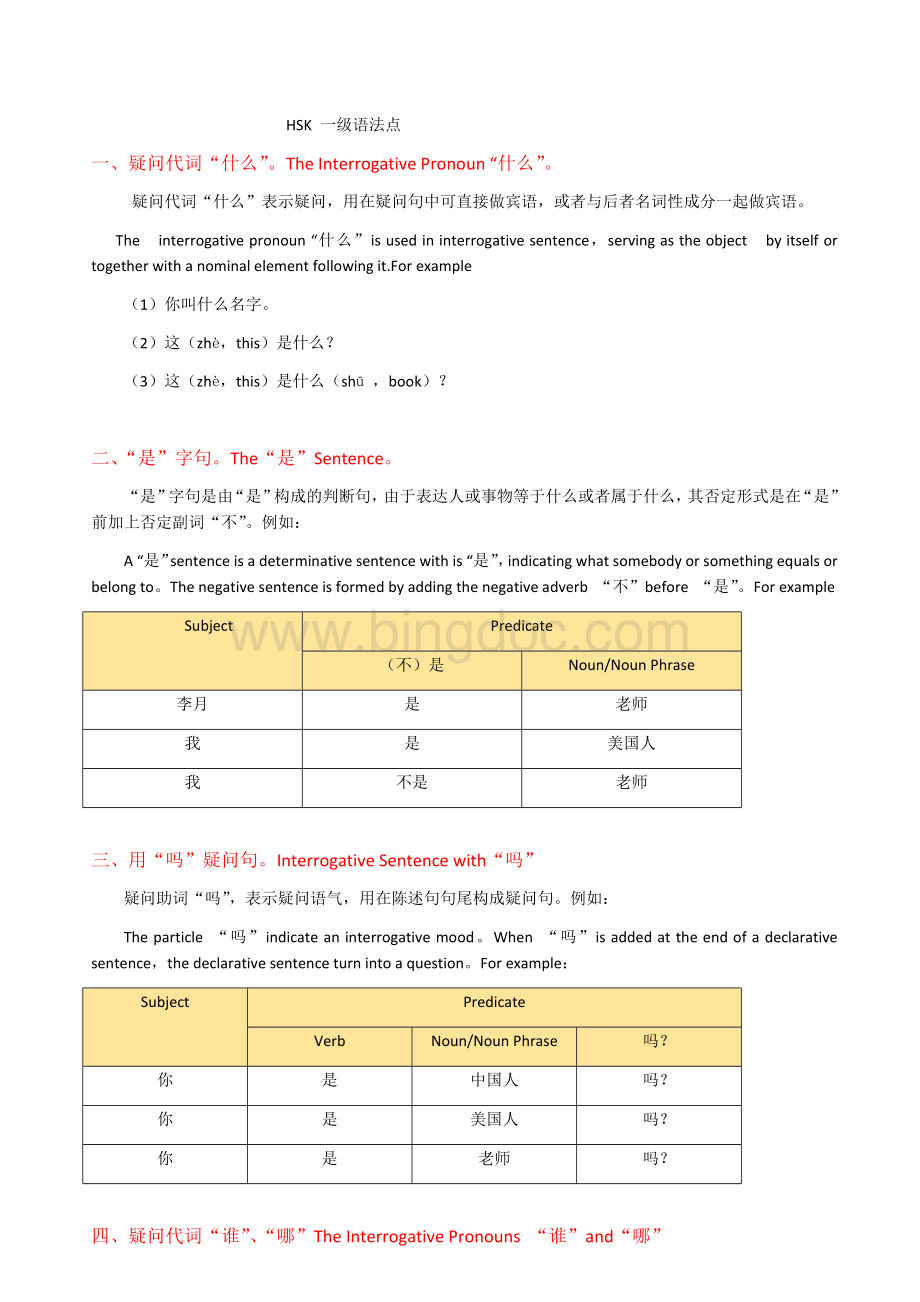课程标准HSK一级语法点.docx
《课程标准HSK一级语法点.docx》由会员分享,可在线阅读,更多相关《课程标准HSK一级语法点.docx(17页珍藏版)》请在冰点文库上搜索。

HSK一级语法点
一、疑问代词“什么”。
TheInterrogativePronoun“什么”。
疑问代词“什么”表示疑问,用在疑问句中可直接做宾语,或者与后者名词性成分一起做宾语。
Theinterrogativepronoun“什么”isusedininterrogativesentence,servingastheobjectbyitselfortogetherwithanominalelementfollowingit.Forexample
(1)你叫什么名字。
(2)这(zhè,this)是什么?
(3)这(zhè,this)是什么(shū,book)?
二、“是”字句。
The“是”Sentence。
“是”字句是由“是”构成的判断句,由于表达人或事物等于什么或者属于什么,其否定形式是在“是”前加上否定副词“不”。
例如:
A“是”sentenceisadeterminativesentencewithis“是”,indicatingwhatsomebodyorsomethingequalsorbelongto。
Thenegativesentenceisformedbyaddingthenegativeadverb“不”before“是”。
Forexample
Subject
Predicate
(不)是
Noun/NounPhrase
李月
是
老师
我
是
美国人
我
不是
老师
三、用“吗”疑问句。
InterrogativeSentencewith“吗”
疑问助词“吗”,表示疑问语气,用在陈述句句尾构成疑问句。
例如:
Theparticle“吗”indicateaninterrogativemood。
When“吗”isaddedattheendofadeclarativesentence,thedeclarativesentenceturnintoaquestion。
Forexample:
Subject
Predicate
Verb
Noun/NounPhrase
吗?
你
是
中国人
吗?
你
是
美国人
吗?
你
是
老师
吗?
四、疑问代词“谁”、“哪”TheInterrogativePronouns“谁”and“哪”
(一)、疑问代词“谁”在疑问句中用来询问人。
例如:
Theinterrogativepronoun“谁”isusedtoaskaboutthenameoridentityofaperson。
Forexample:
Subject
Verb
Object
谁
是
李月?
他
是
谁?
她
是
谁?
(二)、疑问代词“哪”用在疑问句中的结构形式为:
哪+量词/名词+名词。
例如
Whentheinterrogativepronoun“哪”isusedinaquestion,thestructureis“哪+measureword/noun+noun”Forexample:
(1)哪本(běn,ameasurewordforbooks)书(shū,book)?
(2)哪个(gè,ageneralmeasureword)人?
(3)你是哪国人?
五、结构助词“的”Thestructuralparticle“的”
名词/代词+的+名词表达一种所属关系。
当“的”后的名词是亲属称谓或者指人的名词时,“的”可以省略。
例如:
Thestructure“noun/pronoun+的+noun”indicatepossession.Whenthenounfollowing“的”isaternofkinshiporindicateaperson,“的”canbeomitted.Forexample:
(1)李月是我的汉语老师。
(2)这(zhè,this)是我的书(shū,book)。
(3)她不是我同学,她是我朋友。
六、疑问助词“呢”
(1)TheInterrogativeParticle“呢”
(1)
疑问助词“呢”用在名词后或代词后构成疑问句,用于询问上文提到的情况。
常用的句式是:
A..........。
B呢?
例如:
TheInterrogativeparticle“呢”isusedafteranounorpronoun,formingaquestionaboutthesituationmentionedpreviously.Thecommonlyusedsentencepatternis“A.......。
B呢?
”(A......。
WhataboutB).Forexample:
(1)我不是老师,我是学生。
你呢?
(2)她叫李月,他呢?
(3)我是美国人。
你呢?
七、疑问代词“几”TheInterrogativePronoun“几”
疑问代词“几”是用来询问数量的多少,一般用于询问10以下的数字。
例如:
Theinterrogativepronoun“几”isusedtoaskaboutanumber,usuallylessthan10.Forexample
(1)你有几个汉语老师?
(2)李老师家有几口人?
(3)你女儿几岁了?
八、百以内的数字Numberbelow100
1yī
2èr
3sān
4sì
5wǔ
6liù
7qī
8bā
9jiǔ
10shí
20èrshí
23
èrshísān
30sānshí
40sìshí
50wǔshí
56
Wǔliù
60liùshí
70qīshí
80bāshí
88
bāshíbā
90jiǔshí
99
jiǔshíjiǔ
九、“了”表变化“了”IndicatingaChange
“了:
用于句末,表示变化或新情况的出现。
例如:
“了”isusedattheendofasentencetoindicateachangeortheoccurrenceofanewsituation.Forexample:
(1)李老师今年50岁了。
(2)我朋友的女儿今年四岁了。
(3)你女儿几岁了?
十、“多+大”表示疑问TheInterrogativePhrase“多+大”
“多+大”在句子中表示疑问,用于询问年龄。
例如:
“多+大”isusedtoaskaboutone’sage.Forexample:
(1)你多大了?
(2)你女儿今年多大了?
(3)李老师多大了?
十一、能愿动词“会”
(1)TheModalVerb“会”
(1)
能愿动词“会”用在动词前表示通过学习而获得某种能力,它的否定形式是“不会”。
例如:
Themodalverb“会”isusedbeforeaverb,indicatingacquiringabilitythroughlearning。
Itsnegativeformis“不会”。
Forexample:
Subject
(不)会
Verb
我
会
写汉字
我
不会
做中国菜
你妈妈
会
说汉语吗?
十二、形容词谓语句SentencewithanAdjectivalPredicate
形容词可以用在主语+程度副词+形容词这个结构中,描述人或者事物的性质或者状态,程度副词经常用“很”。
否定形式为主语+不+形容词。
例如:
Usedinthestructure”subject+adverbofdegree+adjective”,theadjectivedescribesthenatureorstateofsomebodyorsomething,usuallyfollowingtheadverbofdegree“很”。
Thenegativeformis“subject+不+adjective”。
Forexample:
Subject
AdverbofDegree/不
Adjective
我
很
好
我妈妈的汉语
不
好
中国菜
很
好吃
十三、疑问代词“怎么”
(1)TheInterrogativePronoun“怎么”
(1)
疑问代词“怎么”用在动词前,询问动作的方式。
例如
TheInterrogativepronoun“怎么”isusedbeforeaverbtoaskaboutthemannerofanaction。
Forexample:
(1)这个汉字怎么读?
(2)你的汉语名字怎么写?
(3)这个字怎么写?
十四、日期的表达
(1):
月、日(rì,date)/号、星期
ExpressofaDate
(1):
month,date,dayoftheweek
汉语的日期表达方式遵循由大小的原则,先说“月”,然后说“日/号”,最后说“星期”。
口语一般常用“号”。
例如:
ThewaytosayadateinChineseobservedtheprincipleof“thebiggerunitcomingbeforethesmallerone“,Themonthissaidfirst,thenthedateandfinallythedayoftheweek.InspokenChinese,“号”isoftenusedinsteadof“日”toexpressthedate.Forexample:
(1)9月1号,星期三。
(2)9月2号,星期四。
(3)8月31号,星期二。
十五、名词谓语句是SentencewithaNominalPredicate
名词谓语句是谓语部分由名词性成分充当的句子,一般用于表达年龄、时间、日期等。
例如:
AsentencewithanominalPredicateisasentencewhosePredicateisanominalelement。
Itisusuallyusedtoindicateage,time,dateandsoon。
Forexample
Subject
Predicate
我的汉语老师
33岁
明天
星期二
今天
9月1号
十六、连动句
(1):
去+地方+做什么
SentencewithaSerialVerbConstruction
(1)去+place+todosth
连动句的谓语部分是由两个或者两个以上动词构成,后一个动作可以表示前一个动作的目的。
第一个动词后表示地点的宾语有时可以省略。
例如:
Thepredicateofasentencewithaserialverbconstructionconsistsoftwoormoreverb.Thelatterverbcanbethepurposeoftheformer.Theobjectofthefirstverb,i.e.theplace,cansometimebeomitted.Forexample:
Subject
Verb1
Verb2
去
(place)
todosth
我
去
(中国)
学习汉语
我们
去
(中国饭馆)
吃中国菜
我
去
(学校)
看书
十七、能愿动词“想”TheModalVerb“想”
能愿动词“想”,一般用在动词前表示一种希望或者打算。
例如:
Themodalverb“想“isusuallyusedbeforeaverbtoexpressahopeorplan.Forexample:
(1)我想学汉语。
(2)明天我想去学校看书
(3)我想买一个杯子。
十八、疑问代词”多少”TheInterrogativePronoun“多少”。
疑问代词“多少”用于询问十以上的数量,“多少”后边的量词可以省略。
“多少”还用于询问价格,常用于表达方式“...........多少钱?
”。
例如:
Theinterrogativepronoun“多少”isusedtoaskaboutnumberlargerthan10.Themeasurewordfollowingcanbeomitted.”多少”canalsobeusedtoinquireaboutprices,usuallyinthesentencepattern“...........多少钱?
”。
Forexample:
(1)你们学校有多少(个)学生?
(2)你有多少(个)汉语老师?
(3)这个杯子多少钱?
十九、量词“个”“口”ThemeasureWord“个”and“口”
“个”是汉语中最常见的一个量词,一般用于没有专用量词的名词前,例如:
“个”isthemostcommonmeasurewordinChinese,usuallyusedbeforeanounwithoutaspecificmeasurewordofitswon.Forexample:
(1)三个老师。
(2)五个学生。
(3)一个杯子。
“口”也是一个量词,一般用于描述家庭成员的人数。
例如:
“口”isameasurewordtoo,usuallyusedformemberofafamily.Forexample:
(1)李老师家有六口人。
(2)你家有几口人?
(3)我家有三口人。
二十、动词“在”TheVerb“在”
“在”是动词,后边加上表示位置的词语做句子的谓语,用于指示人或者事物的位置。
例如:
“在”isaverb.Whenitisfollowedbyawordoflocalityandactsasthepredicateofasentence,itindicatesthelocationofsomebodyorsomething.Forexample:
Subject
Predicate
在
Wordoflocality/Direction
我朋友
在
学校
我妈妈
在
家
小狗
在
椅子下面
二十一、疑问代词“哪儿”TheInterrogativePronoun“哪儿”
疑问代词“哪儿”用于疑问句中,询问人或事物的位置。
例如:
TheInterrogativepronoun“哪儿”isusedtoaskaboutthelocationofsomebodyorsomething.Forexample:
(1)我的杯子在哪?
(2)你的中国朋友在哪儿?
(3)小猫在哪儿?
二十二、介词“在”ThePreposition“在”
“在”也是介词,后边加上表示位置的词语,用于介绍动作行为发生的位置。
例如:
“在”canalsoactasapreposition,usedbeforeawordoflocalitytointroducetheplacewhereanactionorbebehaviortakesplace.Forexample:
Subject
Predicate
在
Wordoflocality/Direction
Verb
我
在
朋友家
喝茶
他们
在
学校
看书
我儿子
在
医院
工作
二十三、疑问助词“呢”
(2)TheInterrogativeParticle“呢”
(2)
疑问助词“呢”用在句末,表示疑问,用于询问人或事物的位置。
例如:
Usedattheendofasentence,theinterrogativeparticle“呢”askaboutthelocationofsomebodyorsomething.Forexample:
(1)我的小猫呢?
(2)我的杯子呢?
(3)他在哪儿呢?
二十四、“有”字句:
表示存在The“有”Sentence:
indicatingexistence
动词“有”可以用于表示存在的句子中,表示某个处所或者位置存在什么。
例如:
Theverb“有”canbeusedinanexistentialsentencetoindicateapersonorthingexistssomewhere.Theexample:
Wordoflocality
有
Person/ThingExisting
椅子下面
有
一只小狗
学校里
有
一个商店
桌子上
有
一个电脑和一本书
“有”字句的否定形式是“没有”,同时宾语前不能带数量定语。
例如:
Inthenegativeformofa“有”sentence,“没有”isusedwithoutanumeralclassifierbeforetheobject.Forexample:
(1)椅子下面没有小狗。
(2)学校里没有商店。
(3)桌子上没有电脑和书。
二十五、连词“和”TheConjunction“和”
连词“和”用于连接两个或者两个以上并列的成分,表示一种并列关系。
例如:
Theconjunction“和”isusedtoconnecttwoormoreelement,indicatingaparallel
relationship.Forexample:
(1)我家有一个中国人朋友和一个美国朋友。
(2)我家有三口人,爸爸、妈妈和我。
(3)桌子上有一个电脑和一本书。
二十六、能愿动词“能”TheModalVerb“能”
能愿动词“能”一般用在动词前,与动词整体做谓语,表示一种能力或者可能。
“能”还常用于疑问句式“能.........吗?
”中,表示请求,希望获得许可。
例如:
Themodalverb“能”isusuallybeforeaverbtoformthepredicatinganabilityorapossibility.Theinterrogativesentencestructure“能........吗?
”isoftenusedtoindicatearequestorhopeforpermission.Forexample:
(1)明天下午我能去商店。
(2)你能在这儿写你的名字吗?
(3)我能坐这儿吗?
二十七、用”请”的祈使句ImperativeSentencewith“请”
动词“请”后加其他动词可以构成一种祈使句,委婉地表达建议、希望对方做某事。
例如:
Whentheverb“请”isusedbeforeanotherverb,animperativesentenceisformed,indicatingapolitesuggestionorhope.Forexample
(1)请写您的名字。
(2)请喝茶。
(3)请坐。
二十八、时间的表达。
Expressoftime.
(1)汉语表达时间的时候要用“点”、“分”,遵循由大到小的顺序。
“点”and“分”areusedtoexpresstimeinChinese,observingtheprincipleof“thebiggerunitprecedingthesmallerunit”.
用“点”来表示整点。
例如:
“点”mean“o’clock“,indicatingawholehour.Forexample:
9:
00→九点11:
00→十一点2:
00→两点
注意:
在表达2o’clock时,我们说两点(liǎngdiǎn),不说二点(èrdiǎn)。
Note:
Thecounterpartof2o’clockinChineseis“两点(liǎngdiǎn)”insteadof“二点(èrdiǎn)”
当不是整点的时候要用到”分”,格式是“........点..........分”。
例如
Ifitisnota“whole-hour”time,“分”isused.Thepatternis“........点..........分”.Forexample:
5:
30→五点三十分11:
10→十一点十分2:
05→两点零(líng,zero)五分
(2)如果区分上午或者下午,一般格式是“上午......点(..........分),下午........点(..........分)”.例如:
Todistinguishatimebeforenoonformoneafternoon,thepattern“上午......点(..........分)”or“下午........点(..........分)"isused.Forexample:
8:
00am→上午八点
3:
10pm→下午三点十分
5:
25pm→下午五点二十五分。
二十九、时间词做状语TimeWordUsedasanAdverbial
时间词在句子中做状语,经常出现在主语后面,也可以在主语前边。
例如:
Whenatimewordservesasanadve